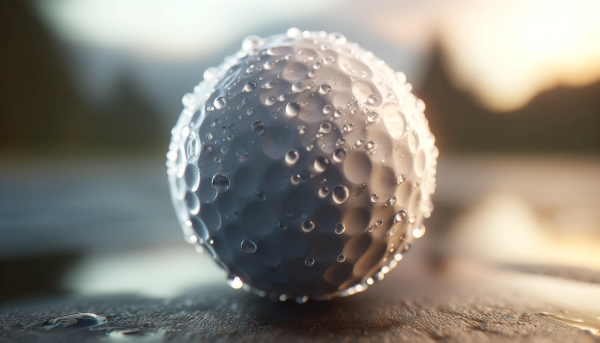Answer this question and please be honest. Have you ever considered the level of humidity when golfing? I am not talking rain here, but proper humidity in the air. If you have, you are among the rare golfers who did that, I certainly haven’t. How humidity affects golf ball trajectory and spin can have a bad or a good effect on your game. It can affect everything from how the ball feels when it meets the clubface to the arc and landing of your ball.
How Humidity Affects Golf Ball Trajectory and Spin
The effect of humidity on a golf ball’s trajectory and spin is subtle, but it can be significant enough to consider. No matter how well you can control your golf ball flight trajectory and add backspin, you will need some tweaks when it is humid. This can be especially the case for competitive play or extreme conditions.
Impact of Humidity on Golf Ball Trajectory
Air Density
- Air Density: Humid air is less dense than dry air. This is because water vapor molecules are lighter than the nitrogen and oxygen molecules they replace in the air. Less dense air provides less resistance to the golf ball.
- Effect on Distance: With less resistance, the golf ball can travel further in humid conditions compared to dry ones.
Ball Speed
- Friction and Spin: It can affect the friction between the clubface and the golf ball. This can slightly alter the amount of spin, influencing its flight path. Generally, the effect is minor but can be more noticeable for skilled players.
- Launch Conditions: Humidity can cause the clubface to be slightly slicker, which may affect the initial launch conditions of the ball.
Temperature Correlation
- Temperature: High humidity often coincides with higher temperatures. Warmer air also has a lower density, contributing to the ball traveling further. However, if the temperature is very high, it can affect the player’s comfort and performance, indirectly affecting the ball’s trajectory.
Ball Compression
- Softness and Feel: Humidity can affect the feel of the golf ball and its compression characteristics, especially with softer balls. This can influence how the ball reacts off the clubface.

Impact of Humidity on Golf Ball Spin
Air Density
- Impact on Spin: Lower air resistance can slightly reduce the amount of spin decay during the ball’s flight. Meaning, that the ball might retain its spin longer in humid conditions compared to dry ones.
Friction Between Club and Ball
- Surface Moisture: High humidity can result in more moisture on the surface of the golf ball and the clubface. This can alter the friction between the clubface and the ball at impact.
- Spin Generation: More moisture can reduce the friction, which may decrease the amount of spin generated on shots. This is particularly noticeable on shots requiring high spin, like approach shots and chips.
Effects on Different Types of Spin
- Backspin: For drives and longer shots, the effect on backspin is minimal but can still be noticeable for professional players or in very humid conditions. The reduced friction might lead to slightly lower backspin rates.
- Side Spin: Side spin, which affects shot shaping like fades and draws, can be slightly reduced due to the lower friction and air density.
Temperature and Humidity
- Combined Effects: Since high humidity often accompanies higher temperatures, the combined effects can be more pronounced. Warmer, humid air can lead to lower friction and reduced air density. Both contribute to lower spin rates and potentially longer ball flights.
Practical Tips
Here are some tips for playing in humid conditions.
- Club Selection: You might need to adjust your club selection to account for the increased distance. For example, you might use one club less than usual for a given distance.
- Strategy: Understanding how humidity affects your shots can help you better plan your approach to each hole. Consider both carry and roll distances.
- Shot Planning: The ball won’t check up as quickly on the greens because of the reduced spin. Plan for more roll-out on approach shots and chips.
- Club and Ball Interaction: Clean contact between the clubface and ball is even more critical in humid conditions. Wiping down the clubface and ball can help maintain friction and control spin.
Use Knowledge to Your Advantage
Experienced and top-tier players adjust their equipment, techniques, and expectations based on the day’s conditions. If it is wet outside, they might choose a ball designed for a higher flight so it descends from a steeper angle and stops quickly on the green. Also, they might tweak their swing to have balls fly higher on approach shots or chips.
You can learn to adapt like professional golfers do. For example, you can practice and play more often in different weather conditions. Learn how your ball behaves when it is dry and hot or wet and cold. This way you will become a more versatile player and be able to adapt to different conditions faster. Use all the knowledge you acquire to your advantage when you are golfing. Be ready and enjoy your round no matter what the weather throws at you.
Do you play in humid conditions? How do you adapt to it? Share below!

